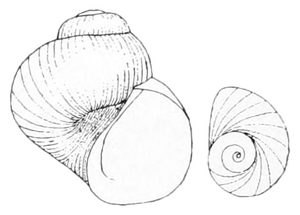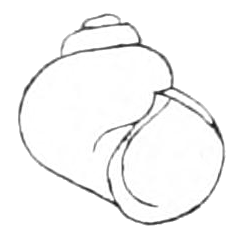Umbilicate pebblesnail facts for kids
Quick facts for kids Umbilicate pebblesnail |
|
|---|---|
 |
|
| Drawing of apertural view of the shell and operculum of Clappia umbilicata | |
 |
|
| Drawing of apertural view of the shell of Clappia umbilicata from its type description by Bryant Walker | |
| Conservation status | |
| Scientific classification | |
| Genus: |
Clappia (gastropod)
|
| Species: |
umbilicata
|
| Synonyms | |
|
|
The umbilicate pebblesnail (scientific name: Clappia umbilicata) was a tiny freshwater snail. It had a special lid called an operculum to close its shell. This snail was a type of aquatic gastropod mollusk. Sadly, this species is now extinct, meaning it has completely died out.
Where It Lived
This snail was found only in the state of Alabama in the United States. This means it was endemic to Alabama. Its main home was the Coosa River near Wetumpka, Alabama.
The umbilicate pebblesnail also lived in other parts of the Coosa River. These places included Duncan's Ripple, The Bar, and Higgin's Ferry in Chilton County. It was also found at Butting Ram Shoals in Coosa County, Alabama.
-
Chilton County, Alabama (marked red) where the snail was found
-
Coosa County, Alabama (marked red) where the snail also lived
What It Looked Like
The umbilicate pebblesnail was first found and described in 1904. An American scientist named Bryant Walker gave it the name Somatogyrus umbilicatus. He studied mollusks, so he was a malacologist.
Walker described the snail's shell as small and round, but a bit flat. It was a light greenish-yellow color. The shell had fine lines from its growth. It had about 3 and a half whorls, which are the turns of the shell. The opening of the shell, called the aperture, was almost round.
The snail itself was black. This means its body parts like its snout, neck, and foot were all black. Scientists later confirmed the black color of its mantle, which is a part of its body that forms the shell.
The umbilicate pebblesnail had a special ribbon-like tongue called a radula. This radula had many rows of tiny teeth, about 56 to 59 rows. These teeth helped the snail scrape its food.
How It Lived and Why It Disappeared

The natural habitat (home) of this snail was rivers. Clappia umbilicata lived only in parts of the river that flowed very fast. These fast-flowing areas are called river shoals.
Sadly, the snail died out because its home changed a lot. A dam was built in 1928, which created Jordan Lake. This dam caused the river to slow down. The slower water led to silting, where fine dirt and mud covered the river bottom. The snail could not survive in these new conditions.
Scientists believe that Clappia umbilicata ate tiny pieces of plants. It used its radula to graze on these very small plant particles. It seemed to prefer even finer food than other snails like those in the Somatogyrus group.






